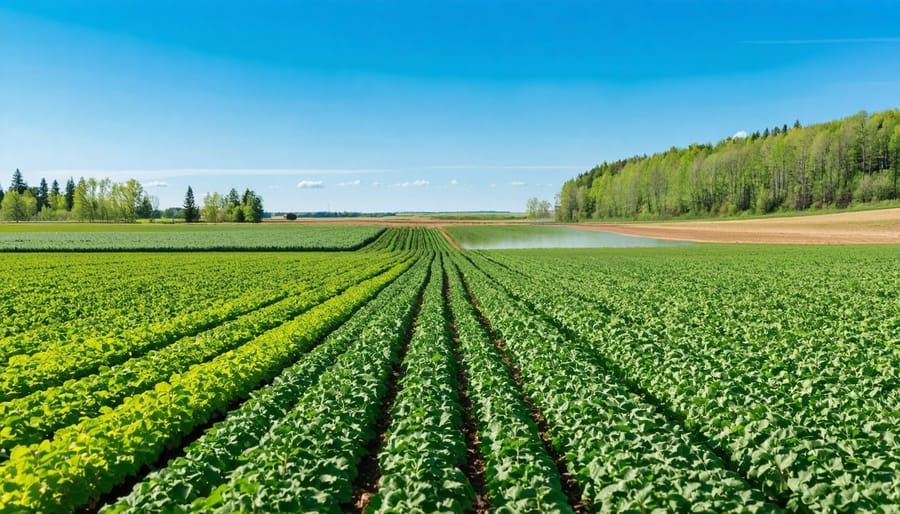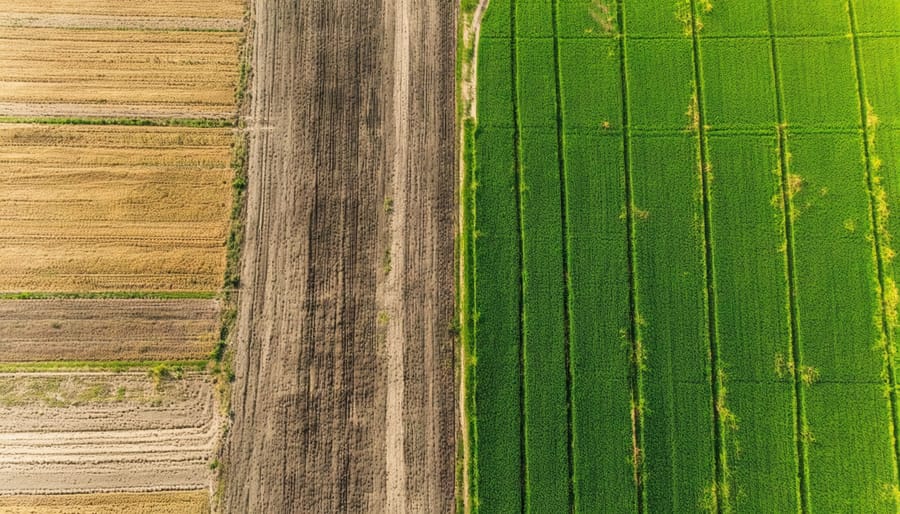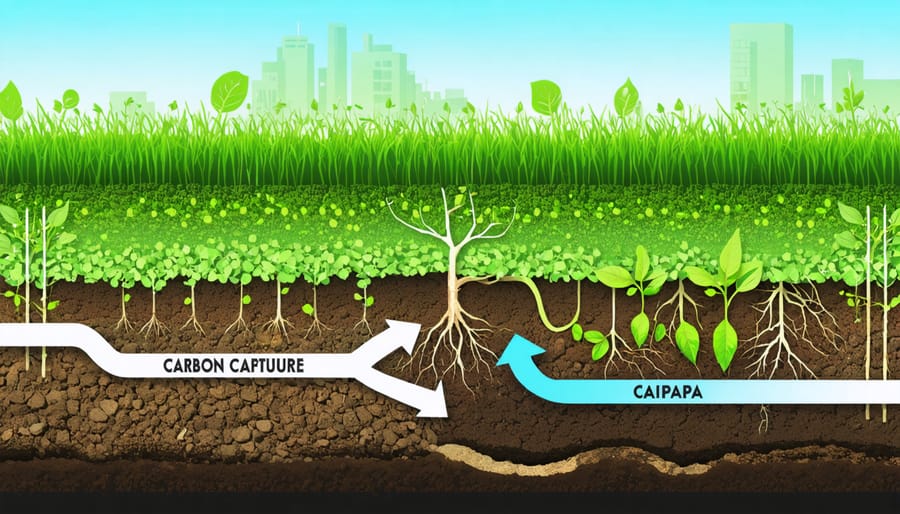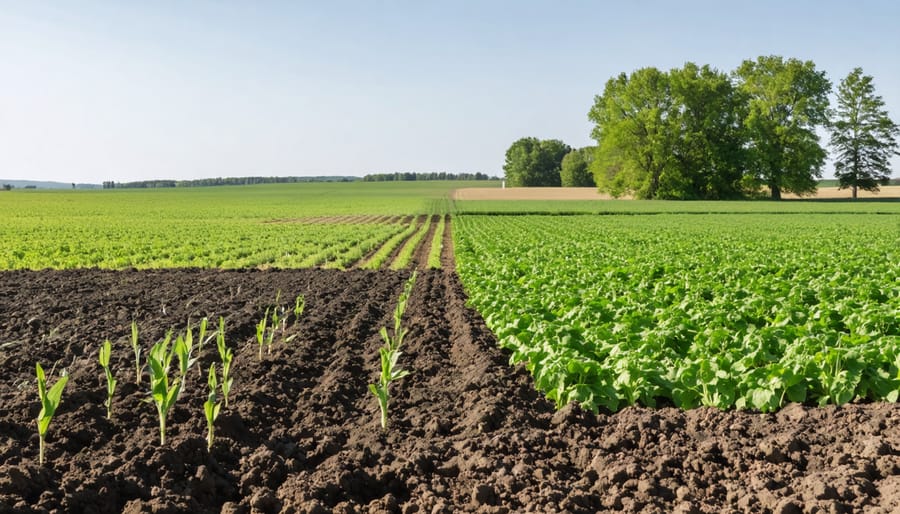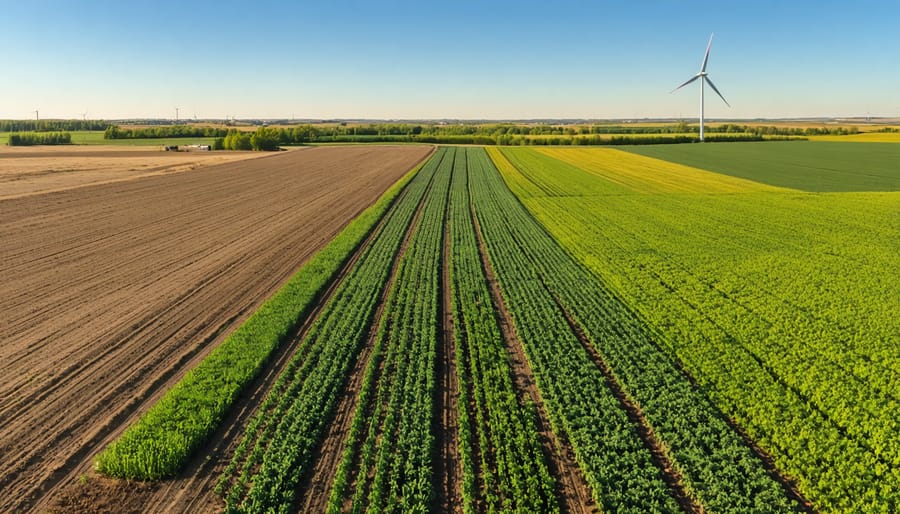Transform your farmland into a profitable carbon asset through proven carbon sequestration practices and strategic investment models. Alberta farmers now generate between $15-30 per hectare annually through soil carbon credits, combining traditional agricultural revenue with emerging carbon markets. Three distinct investment approaches dominate the landscape: direct project development, where farmers maintain full control and maximum returns; aggregator partnerships, offering simplified enrollment and guaranteed minimum payments; and cooperative models, spreading risks and costs across multiple operations while building community resilience. These proven frameworks have already helped over 500 Alberta farmers transition to regenerative practices while securing additional income streams. Select the model that aligns with your operation’s scale, risk tolerance, and management capacity to maximize both environmental and financial returns from your soil carbon initiatives.
Current Carbon Market Opportunities in Alberta
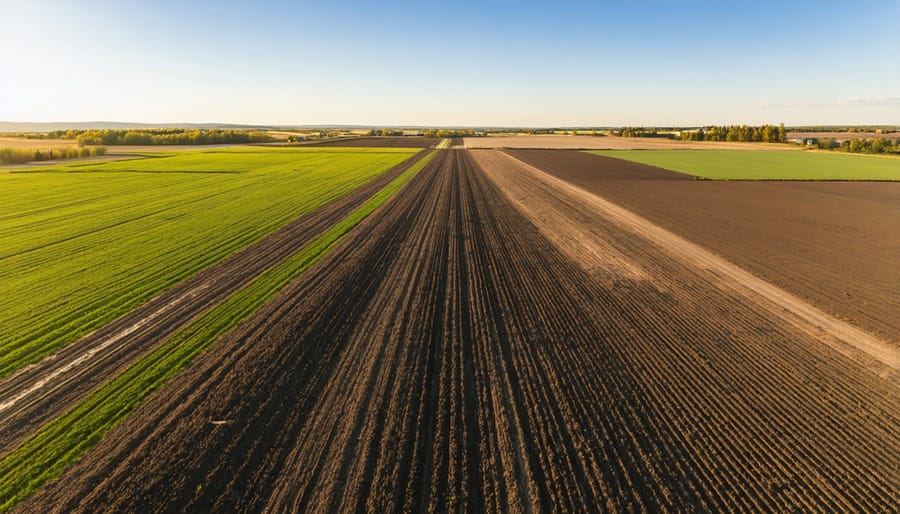
Provincial Carbon Credit Programs
Alberta’s innovative carbon offset system provides farmers with opportunities to earn soil carbon credits through sustainable agricultural practices. The program recognizes various activities that reduce greenhouse gas emissions or sequester carbon in the soil, including conservation tillage, improved grazing management, and enhanced cropping systems.
To participate, farmers must first establish a baseline for their current practices and carbon levels. They then implement approved protocols that demonstrate verifiable carbon reductions or sequestration. The program requires detailed record-keeping and third-party verification every five years to ensure compliance and accuracy of carbon measurements.
Credits are traded through the Alberta Emissions Offset Registry, where they can be purchased by large industrial emitters to meet their compliance obligations. Farmers typically earn between $15 and $30 per tonne of CO2 equivalent, with rates varying based on market conditions and verification timing.
Success in the program often comes from combining multiple practices and working with aggregators who can help manage the verification process and paperwork while connecting farmers with buyers.
Private Market Initiatives
Alberta’s private carbon market has grown significantly, with several key players actively purchasing and brokering carbon credits from farmers. Companies like Radicle Growth and Carbon Credit Solutions have established themselves as trusted intermediaries, helping farmers navigate the verification process and connect with buyers.
These private brokers typically offer competitive prices ranging from $15 to $30 per tonne of sequestered carbon, with some premium buyers willing to pay more for high-quality credits. Many provide additional support services, including soil testing, documentation assistance, and ongoing monitoring guidance.
Local success stories include the Miller family farm near Red Deer, which partnered with a private broker to sell credits generated through their no-till practices. They received $25,000 in their first year of participation, reinvesting the funds into precision agriculture equipment.
For farmers considering private market participation, it’s worth noting that these initiatives often offer more flexibility than government programs. However, contract terms, verification requirements, and payment schedules vary significantly between buyers. Working with established brokers who understand Alberta’s agricultural landscape and have proven track records in the region is recommended.
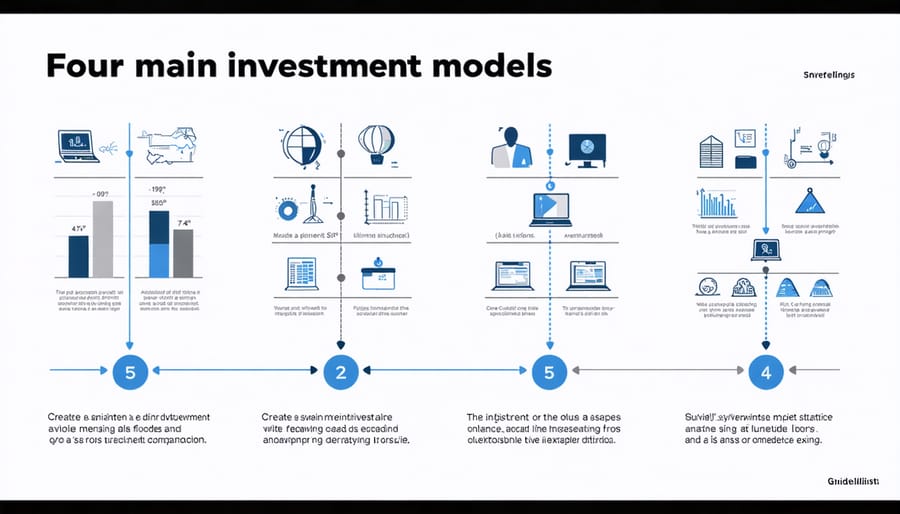
Proven Investment Models for Soil Carbon Projects
Direct Investment Model
The direct investment model represents a straightforward approach where farmers fund their own soil carbon initiatives using personal or business capital. This self-funded strategy gives you complete control over project implementation and ensures you retain 100% of the carbon credits and financial benefits generated.
Many Alberta farmers have successfully implemented this model, including Sarah Thompson from Red Deer County, who invested $75,000 in regenerative agriculture practices across her 400-hectare farm. Within three years, she recovered her initial investment through improved soil productivity and carbon credit sales.
To implement a direct investment model, start by conducting a thorough cost-benefit analysis. Consider immediate expenses like equipment upgrades, soil testing (typically $200-300 per field), and operational changes. Factor in potential returns through increased crop yields, reduced input costs, and carbon credit revenue.
Local agricultural financial advisors recommend maintaining a contingency fund of 15-20% above your projected budget. Many farmers find success by implementing changes gradually, starting with 20-25% of their total acreage to test and refine their approach.
The Agricultural Financial Services Corporation (AFSC) offers specialized lending programs for sustainability projects, which can supplement your investment if needed. Remember to document all your practices and maintain detailed records – this will be crucial for carbon credit verification and future funding opportunities.
Partnership-Based Model
The partnership-based model represents a collaborative approach to soil carbon initiatives, bringing together farmers, agribusinesses, and carbon buyers in mutually beneficial arrangements. In Alberta, several successful partnerships have emerged between agricultural cooperatives and major carbon purchasers, creating streamlined pathways for farmers to access carbon markets.
Under this model, farmers typically partner with established agribusinesses that provide technical support, soil testing services, and market access. These partnerships often include guaranteed purchase agreements for carbon credits, reducing market uncertainty for producers. For example, the Southern Alberta Grain Collective has successfully connected over 200 local farmers with international carbon buyers through their cooperative structure.
The financial arrangements in these partnerships usually involve shared risk and reward. Agribusiness partners commonly cover initial soil testing costs and provide implementation support, while farmers commit to specific practice changes and data sharing. Carbon buyers may offer premium prices through these arrangements, recognizing the quality assurance provided by established partnerships.
Many Alberta farmers report that partnership models reduce administrative burden and provide valuable networking opportunities. Local success stories include the Prairie Soil Carbon Initiative, where participating farmers have accessed premium carbon markets while receiving ongoing technical support and training through their agribusiness partners.
This collaborative approach particularly benefits smaller operations that might otherwise struggle to access carbon markets independently, creating a more inclusive pathway to soil carbon program participation.
Cooperative Investment Model
The cooperative investment model has emerged as a powerful solution for farmers looking to maximize their potential for profiting from carbon initiatives. By pooling resources and sharing costs, groups of neighboring farms can create economies of scale that make carbon projects more financially viable and administratively manageable.
In Alberta, successful cooperatives typically involve 5-10 farms working together, sharing equipment, expertise, and administrative responsibilities. This collaborative approach reduces individual investment costs by an average of 40% while increasing bargaining power with carbon credit buyers and project developers.
The Wheatland Carbon Cooperative in central Alberta demonstrates this model’s effectiveness. Their 8-member group collectively manages 12,000 hectares under carbon protocols, sharing soil testing costs and collectively negotiating better rates for verification services. Members report both reduced individual risk and increased returns compared to solo projects.
To form a successful cooperative, farmers should:
– Identify committed partners within a 50-kilometer radius
– Establish clear governance structures and decision-making processes
– Create shared equipment and resource management plans
– Develop uniform soil sampling and data collection protocols
– Pool verification and certification costs
– Collectively negotiate with carbon credit buyers
This model particularly benefits smaller operations that might otherwise find carbon project requirements prohibitive, while fostering knowledge-sharing and community support networks.
Third-Party Financing Model
Third-party financing has emerged as a valuable option for Alberta farmers looking to implement soil carbon projects without shouldering the entire financial burden. This model involves partnering with external investors, carbon credit buyers, or agricultural technology companies who provide upfront funding in exchange for a share of future carbon credits or project returns.
Local agricultural credit unions and farm financing institutions across Alberta have developed specialized programs to support soil carbon initiatives. For example, the Mountain View Credit Union offers tailored financing packages that consider both traditional agricultural metrics and carbon project potential when assessing loan applications.
Many carbon project developers now offer “pay-for-performance” arrangements, where they cover initial costs and receive payment only when carbon credits are generated. This approach significantly reduces financial risk for farmers while providing access to necessary expertise and technologies.
Corporate partnerships are also gaining traction, with companies like Nutrien and Farmers Edge offering innovative financing solutions. These partnerships often include technical support, soil testing services, and marketing assistance for carbon credits, creating a comprehensive support system for farmers.
To explore third-party financing options, farmers should:
– Research local agricultural lending institutions
– Connect with established carbon project developers
– Evaluate corporate partnership programs
– Review contract terms carefully, particularly regarding credit sharing and project commitments
– Consult with agricultural financial advisors familiar with carbon markets
Remember to maintain operational control of your farm while leveraging external funding to achieve your soil health and carbon sequestration goals.
Real Success Stories from Alberta Farms
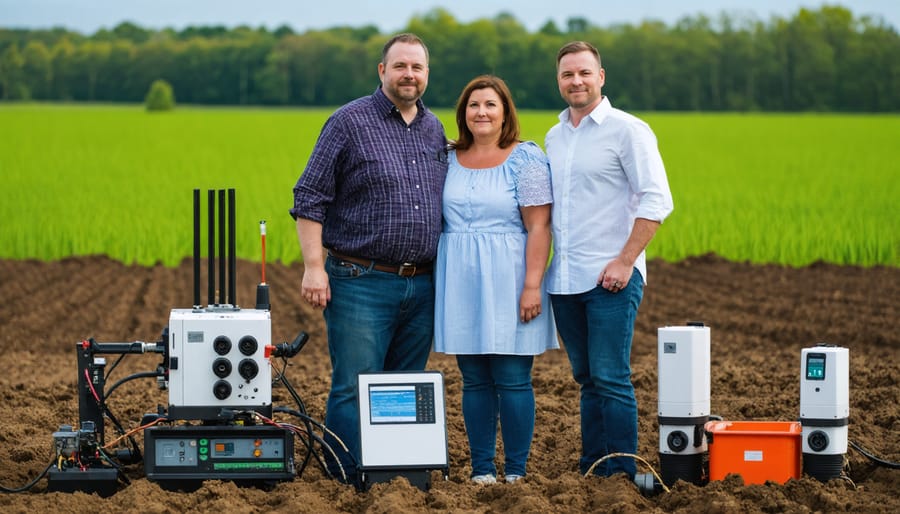
Small-Scale Success: The Thompson Family Farm
Located just outside of Red Deer, Alberta, the Thompson Family Farm has become a shining example of how small-scale operations can successfully participate in carbon farming initiatives. Sarah and Mike Thompson, third-generation farmers managing 300 hectares of mixed cropland, transformed their traditional farming operation into a carbon success story through strategic planning and commitment to soil health.
In 2019, the Thompsons enrolled in Alberta’s Conservation Cropping Protocol, implementing no-till practices and diverse crop rotations. Their initial investment included $45,000 for equipment modifications and soil testing. Within two years, they generated 450 carbon credits, equivalent to approximately $13,500 in additional revenue.
“We weren’t sure about the paperwork at first,” shares Sarah Thompson, “but the local agricultural extension office helped us navigate the process. The financial returns have been great, but we’re most proud of seeing our soil quality improve year after year.”
The Thompsons’ success hinged on careful documentation of their practices, including detailed field records and regular soil testing. They partnered with a local agrologist to optimize their carbon sequestration potential and joined a community of farmers sharing similar goals.
Their story demonstrates that smaller operations can effectively participate in carbon markets while improving soil health and farm sustainability. The Thompsons now mentor other local farmers, sharing their experience and encouraging wider participation in carbon farming initiatives.
Large-Scale Implementation: Prairie Heritage Cooperative
The Prairie Heritage Cooperative in central Alberta stands as a shining example of successful large-scale carbon investment implementation. In 2020, the cooperative, comprising 120 grain and oilseed farmers, launched a collective carbon initiative spanning 40,000 hectares of farmland.
The cooperative adopted a unique hybrid investment model, combining member contributions with external funding from agricultural processors and government grants. Each member contributed $5 per hectare to a shared carbon measurement and verification fund, while maintaining individual control over their farming practices.
Key to their success was the establishment of a centralized data management system, allowing members to track and report their carbon-building activities efficiently. The cooperative partnered with local soil testing laboratories to provide members with subsidized soil testing services, ensuring consistent measurement protocols across all properties.
Within two years, participating farms averaged a 0.4% increase in soil organic carbon, translating to approximately 2.2 tonnes of carbon dioxide equivalent per hectare annually. The cooperative successfully negotiated carbon credit agreements with major food processors, securing a premium of $45 per tonne of verified carbon sequestration.
Perhaps most notably, the Prairie Heritage model demonstrated the power of collective action. By pooling resources and sharing knowledge, members reduced individual implementation costs by roughly 40% compared to solo ventures, while maintaining the flexibility to adapt practices to their specific farming conditions.
Getting Started with Your Soil Carbon Project
Beginning your soil carbon project starts with a thorough assessment of your land’s potential. First, conduct comprehensive soil testing to establish your baseline carbon levels – most agricultural service providers in Alberta offer this testing. Document your current farming practices, as this information will be crucial for measuring improvements.
Next, identify which carbon farming practices align with your operation. Consider implementing reduced tillage, cover cropping, or rotational grazing. These methods not only enhance soil carbon but can also improve your soil’s overall health and productivity. Understanding the costs of soil carbon storage will help you plan your investment effectively.
Connect with local agricultural extension services and carbon project developers who can guide you through the verification and registration process. Alberta’s carbon offset system requires proper documentation and third-party verification to ensure your efforts qualify for carbon credits.
Create a timeline for implementation, starting with smaller pilot areas if needed. Many successful Alberta farmers began with test plots before scaling up their carbon farming practices. Remember to join local farmer networks and study groups – learning from others’ experiences can help you avoid common pitfalls and accelerate your success.
Finally, establish a monitoring system to track your progress. Regular soil testing and detailed record-keeping will help demonstrate the effectiveness of your carbon storage efforts and support your carbon credit claims.
As we’ve explored together, investing in soil carbon initiatives offers Alberta farmers multiple pathways to enhance both environmental stewardship and farm profitability. Whether through carbon credit programs, government incentives, or private partnerships, there’s a model that can work for your operation. The success stories from fellow Alberta farmers demonstrate that these investments not only improve soil health but also create lasting economic benefits for our agricultural communities.
Take the first step by assessing your farm’s current practices and exploring the investment models that align with your goals. Remember, you’re not alone in this journey – our strong network of agricultural professionals, government resources, and farmer cooperatives are here to support your transition. By acting now, you’ll be positioning your farm for long-term sustainability while contributing to Canada’s climate solutions. Let’s work together to build a more resilient and profitable agricultural future for Alberta.

